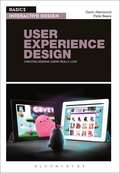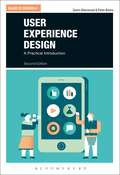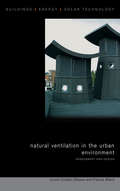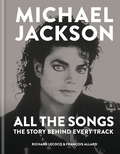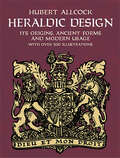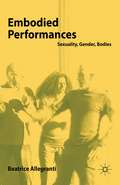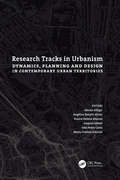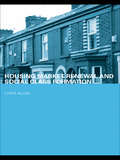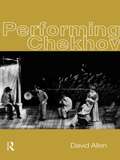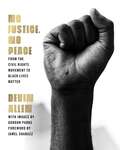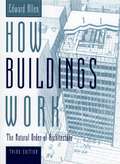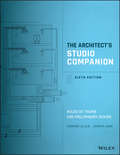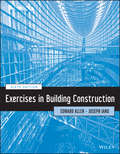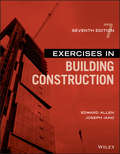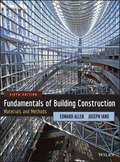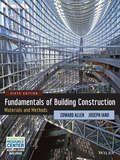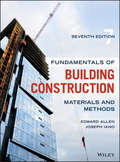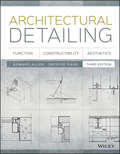- Table View
- List View
Basics Interactive Design: Creating designs users really love (Basics Interactive Design)
by Gavin Allanwood Peter BeareUser Experience (UX) and User Experience Design (UXD) challenge existing usability models by changing the emphasis from task and usage to a broader understanding of experience and purpose. UX techniques are gaining popularity across a range of current digital media design and development areas. Today's designers need to create work that will impact positively on everyone who is exposed to it, as work is delivered across diverse digital platforms accessible to huge populations. It may be passive and immutable or interactive and dynamic, but the success of the design will depend largely on how well the user experience is constructed.Basics Interactive Design 02: User Experience Design introduces an approach to graphic design that puts human experience at the forefront of the design process. Throughout the book, Gavin Allanwood and Peter Beare show how design skills can be improved by undertaking practical exercises and reviewing the work, style and motivations of leading practitioners.
Basics Interactive Design: Creating designs users really love (Basics Interactive Design)
by Gavin Allanwood Peter BeareBy putting people at the centre of interactive design, user experience (UX) techniques are now right at the heart of digital media design and development. As a designer, you need to create work that will impact positively on everyone who is exposed to it. Whether it's passive and immutable or interactive and dynamic, the success of your design will depend largely on how well the user experience is constructed.User Experience Design shows how researching and understanding users' expectations and motivations can help you develop effective, targeted designs. The authors explore the use of scenarios, personas and prototyping in idea development, and will help you get the most out of the latest tools and techniques to produce interactive designs that users will love.With practical projects to get you started, and stunning examples from some of today's most innovative studios, this is an essential introduction to modern UXD.
User Experience Design: A Practical Introduction (Basics Design)
by Gavin Allanwood Peter BeareApplicable to a wide spectrum of design activity, this book offers an ideal first step, clearly explaining fundamental concepts and methods to apply when designing for the user experience.Covering essential topics from user research and experience design to aesthetics, standards and prototyping, User Experience Design explains why user-centered methods are now essential to ensuring the success of a wide range of design projects.This second edition includes important new topics including; digital service standards, onboarding and scenario mapping. There are now 12 hands-on activities designed to help you start exploring basic UX tasks such as visualising the user journey and recognising user interface patterns.Filled with straightforward explanations and examples from around the world, this book is an essential primer for students and non-designers needing an introduction to contemporary UX thinking and common approaches. Designed specifically for newcomers to UX Design, the companion website offers extra material for hands-on activities, templates, industry interviews, contributor notes and sources of guidance for those seeking to start a career in the industry.
User Experience Design: A Practical Introduction (Basics Design)
by Gavin Allanwood Peter BeareApplicable to a wide spectrum of design activity, this book offers an ideal first step, clearly explaining fundamental concepts and methods to apply when designing for the user experience.Covering essential topics from user research and experience design to aesthetics, standards and prototyping, User Experience Design explains why user-centered methods are now essential to ensuring the success of a wide range of design projects.This second edition includes important new topics including; digital service standards, onboarding and scenario mapping. There are now 12 hands-on activities designed to help you start exploring basic UX tasks such as visualising the user journey and recognising user interface patterns.Filled with straightforward explanations and examples from around the world, this book is an essential primer for students and non-designers needing an introduction to contemporary UX thinking and common approaches. Designed specifically for newcomers to UX Design, the companion website offers extra material for hands-on activities, templates, industry interviews, contributor notes and sources of guidance for those seeking to start a career in the industry.
Natural Ventilation in the Urban Environment: Assessment and Design (BEST (Buildings Energy and Solar Technology))
by Francis Allard Cristian GhiausThroughout the world, there is an increasing interest in ecological design of buildings, and natural ventilation has proved to be the most efficient low-energy cooling technique. Its practical application, however, is hindered by the lack of information on the complex relationship between the building and its urban environment. In this book, a team of experts provide first-hand information and tools on the efficient use of natural ventilation in urban buildings. Key design principles are explained, enabling readers to decide on the best solution for natural ventilation of buildings, taking into account climate and urban context. In the initial sketches, architects need answers to open problems such as 'what kind of solution to adopt' and 'how to modify existing strategies to exploit the potential of the site'. This book formalizes the multi-criteria analysis of candidate solutions based on quantitative and qualitative estimation of the driving forces (wind and buoyancy), as well as of the barriers induced by the urban environment (wind speed reduction, noise and pollution) and gives a methodology for optimal design of openings. The book is accompanied by a FREE CD, containing software for assessing the potential of a given site, estimating wind speed and dimensioning the openings for natural ventilation. The methodologies and tools are tested, self-contained and user friendly. About the editors The editors, Cristian Ghiaus and Francis Allard, are affiliated with the University of La Rochelle, France. The authors and reviewers combine expertise from universities, research institutions and industry in Belgium, France, Great Britain, Greece, Portugal and Switzerland.
Michael Jackson: The Story Behind Every Track
by François Allard Richard LecocqPlease note: this edition is text only and does not contain images.This is the full story of every single song that Michael Jackson recorded and released during his long and remarkable solo career.With fascinating stories and detailed information on every track - as well as key early songs with The Jackson Five and his legendary dance moves and videos - All the Songs is the complete history of one of the greatest musical legacies of all time.Arranged chronologically by album, expert authors Lecocq and Allard explore the details behind early hits such as ABC and I Want You Back, to solo masterpieces such as Don't Stop 'Til You Get Enough, Billie Jean, Beat It, Smooth Criminal, Black or White, This Is It and more - including outtakes, duets and rare tracks.Explore the magic behind the King of Pop's music with this in-depth, captivating book.
Heraldic Design: Its Origins, Ancient Forms and Modern Usage
by Hubert AllcockThrough the ages, as warfare and competitive rituals became more elaborate, heraldry evolved into an exact art and science. Used to denote accomplishments as well as the genealogies of outstanding individuals and families, these symbols survived the way of life that created them.This remarkably rich sourcebook of royalty-free designs describes the origins and ancient forms of heraldic devices, shields, and trademarks. Over 500 black-and-white drawings trace the history and meaning of the coat, shield, crests, helmets, blazonry, and "attitudes and attributes" of symbols, with considerable attention given to devices such as beasts, monsters, and human and part-human figures. American, British, French, Russian, and other coats of arms are displayed, as are insignias of the Pope and clergy, state seals, and emblems of many modern institutions. In addition to personal, commercial, and family arms, chapters also provide information on the use of heraldry in advertising, brand-labeling, and related fields.A valuable visual reference for anyone interested in genealogy, these handsome images will add a touch of class to a variety of art and craft projects.
Embodied Performances: Sexuality, Gender, Bodies
by B. AllegrantiWith a companion website that includes short online film episodes, this book proposes expansive ways of deconstructing and re-constituting sexuality and gender and thus more embodied and ethical ways of 'doing' life, and offers an understanding and critique of embodiment through an integration of performance, psychotherapy and feminist philosophy.
Research Tracks in Urbanism: Dynamics, Planning and Design in Contemporary Urban Territories
by Alessia AllegriMaybe the Global Village metaphor has never been more accurate than it is today, where societies join forces in the fight against the COVID 19 pandemic, in a global coordinated effort, possibly never tested before in the known history of Humankind. Although we are sure that in the past some other shared demands have united the different peoples of the world, this has never been so strongly necessary, mainly in what the global scientific community is concerned. This is a fight for the survival of a society. However, we should not lose sight of what we are fighting for. We fight together for people. Not just for the abstract value of Human life, but for life in society as a whole, including its moral and ethical aspects. The topics of this book are based on this claim, on what makes it possible. We do not build our lives in a vacuum, or in distant Invisible Cities, but through a higher value, which represents physical life in society: the City, built by the discipline of Urbanism. This book is a spin-off of the International Research Seminar on Urbanism_SIIU2020. Inspired by the contents of twelve research seminars, a group of researchers from the universities of Barcelona, Lisbon and São Paulo discuss the contemporary agenda of research in Urbanism. Following the conference, a selection of 35 original double-blind peer-reviewed research papers were brought together with different perspectives about such an agenda.
Research Tracks in Urbanism: Dynamics, Planning and Design in Contemporary Urban Territories
by Alessia Allegri Angélica Benatti Alvim Eunice Helena Abascal Joaquin Sabaté João Pedro Costa Maria Cristina SchicchiMaybe the Global Village metaphor has never been more accurate than it is today, where societies join forces in the fight against the COVID 19 pandemic, in a global coordinated effort, possibly never tested before in the known history of Humankind. Although we are sure that in the past some other shared demands have united the different peoples of the world, this has never been so strongly necessary, mainly in what the global scientific community is concerned. This is a fight for the survival of a society. However, we should not lose sight of what we are fighting for. We fight together for people. Not just for the abstract value of Human life, but for life in society as a whole, including its moral and ethical aspects. The topics of this book are based on this claim, on what makes it possible. We do not build our lives in a vacuum, or in distant Invisible Cities, but through a higher value, which represents physical life in society: the City, built by the discipline of Urbanism. This book is a spin-off of the International Research Seminar on Urbanism_SIIU2020. Inspired by the contents of twelve research seminars, a group of researchers from the universities of Barcelona, Lisbon and São Paulo discuss the contemporary agenda of research in Urbanism. Following the conference, a selection of 35 original double-blind peer-reviewed research papers were brought together with different perspectives about such an agenda.
Housing Market Renewal and Social Class (Housing, Planning and Design Series)
by Chris AllenHousing market renewal is one of the most controversial urban policy programmes of recent years. Housing Market Renewal and Social Class critically examines the rationale for housing market renewal: to develop 'high value' housing markets in place of the so-called 'failing markets' of low-cost housing. Whose interests are served by such a programme and who loses out? Drawing on empirical evidence from Liverpool, the author argues that housing market renewal plays to the interests of the middle classes in viewing the market for houses as a field of social and economic 'opportunities', a stark contrast to a working class who are more concerned with the practicalities of 'dwelling'. Against this background of these differing attitudes to the housing market, Housing Market Renewal and Social Class explores the difficult question of whether institutions are now using the housing market renewal programme to make profits at the expense of ordinary working-class people. Reflecting on how this situation has come about, the book critically examines the purpose of current housing market renewal policies, and suggests directions for interested social scientists wishing to understand the implications of the programme. Housing Market Renewal and Social Class provides a unique phenomenological understanding of the relationship between social class and the market for houses, and will be compelling reading for anybody concerned with the situation of working class people living in UK cities.
Housing Market Renewal and Social Class (Housing, Planning and Design Series)
by Chris AllenHousing market renewal is one of the most controversial urban policy programmes of recent years. Housing Market Renewal and Social Class critically examines the rationale for housing market renewal: to develop 'high value' housing markets in place of the so-called 'failing markets' of low-cost housing. Whose interests are served by such a programme and who loses out? Drawing on empirical evidence from Liverpool, the author argues that housing market renewal plays to the interests of the middle classes in viewing the market for houses as a field of social and economic 'opportunities', a stark contrast to a working class who are more concerned with the practicalities of 'dwelling'. Against this background of these differing attitudes to the housing market, Housing Market Renewal and Social Class explores the difficult question of whether institutions are now using the housing market renewal programme to make profits at the expense of ordinary working-class people. Reflecting on how this situation has come about, the book critically examines the purpose of current housing market renewal policies, and suggests directions for interested social scientists wishing to understand the implications of the programme. Housing Market Renewal and Social Class provides a unique phenomenological understanding of the relationship between social class and the market for houses, and will be compelling reading for anybody concerned with the situation of working class people living in UK cities.
Performing Chekhov
by David AllenFirst published in 1999. Routledge is an imprint of Taylor & Francis, an informa company.
Performing Chekhov
by David AllenFirst published in 1999. Routledge is an imprint of Taylor & Francis, an informa company.
No Justice, No Peace: From the Civil Rights Movement to Black Lives Matter
by Devin AllenNautilus Book Awards' Better Books for a Better WorldA Movement in Words and Images Award-winning photographer Devin Allen has devoted the last six years to documenting the protests of the Black Lives Matter movement, from its early days in Baltimore, Maryland, up to the present day. The riveting images in No Justice, No Peace provide a lens on the resistance that has empowered Black lives generation after generation. Allen&’s signature black-and-white photos bear witness to the profound history of African Americans and allies in the fight for social justice and portray the collective action over decades in stunning, timeless portraits. Allen&’s remarkable photos of today&’s Black Lives Matter protests, which have been featured in the New York Times, the Washington Post, and twice on the cover of Time magazine, were inspired by Gordon Parks of the Civil Rights Movement, and create a vision of the past and future of Black activism and leadership in America. With contributions from twenty-six bestselling and influential writers and activists of today such as Clint Smith, DeRay Mckesson, D. Watkins, Jacqueline Woodson, Emmanuel Acho, Keeanga-Yamahtta Taylor, and more, alongside the words of past writers and activists such as Martin Luther King Jr, Frederick Douglass, Malcolm X, Maya Angelou, and John Lewis, No Justice, No Peace is a reminder of the moral responsibility of Americans to break unjust laws and take direct action. In words and pictures, No Justice, No Peace honors the connection between activism today and that of the past. If indeed hindsight is 20/20, this artistic look back is a lens on history that enlarges our understanding of the lasting predicament of racism in the United States of America. At once deeply intimate and profoundly uplifting, No Justice, No Peace is a visual tribute to Black resistance and a stern missive on the tough, but necessary, road that lies ahead.
How Buildings Work: The Natural Order of Architecture
by Edward AllenIllustrated with hundreds of illuminating line drawings, this classic guide reveals virtually every secret of a building's function: how it stands up, keeps its occupants safe and comfortable, gets built, grows old, and dies--and why some buildings do this so much better than others. Drawing on things he's learned from the many buildings he himself designed (and in some cases built with his own hands), Edward Allen explains complex phenomena such as the role of the sun in heating buildings and the range of structural devices that are used for support, from trusses and bearing walls to post-tensioned concrete beams and corbeled vaults. He stresses the importance of intelligent design in dealing with such problems as overheating and overcooling, excessive energy use, leaky roofs and windows, fire safety, and noisy interiors. He serves up some surprises: thermal insulation is generally a better investment than solar collectors; board fences are not effective noise barriers; there's one type of window that can be left open during a rainstorm. The new edition emphasizes "green" architecture and eco-conscious design and construction. It features a prologue on sustainable construction, and includes new information on topics such as the collapse of the World Trade Center, sick building syndrome, and EIFS failures and how they could have been prevented. Allen also highlights the array of amazing new building materials now available, such as self-cleaning glass, photovoltaics, transparent ceramics, cloud gel, and super-high-strength concrete and structural fibers. Edward Allen makes it easy for everyone--from armchair architects and sidewalk superintendents to students of architecture and construction--to understand the mysteries and complexities of even the largest building, from how it recycles waste and controls the movement of air, to how it is kept alive and growing.
The Architect's Studio Companion: Rules of Thumb for Preliminary Design
by Edward Allen Joseph IanoThe time-saving resource every architect needs The Architect’s Studio Companion is a robust, user-friendly resource that keeps important information at your fingertips throughout the design process. It includes guidelines for the design of structure, environmental systems, parking, accessibility, and more. This new sixth edition has been fully updated with the latest model building codes for the U.S. and Canada, extensive new information on heating and cooling systems for buildings, and new structural systems, all in a form that facilitates rapid preliminary design. More than just a reference, this book is a true companion that no practicing architect or student should be without. This book provides quick access to guidelines for systems that affect the form and spatial organization of buildings and allows this information to be incorporated into the earliest stages of building design. With it you can: Select, configure, and size structural systems Plan for building heating and cooling Incorporate passive systems and daylighting into your design Design for parking and meet code-related life-safety and accessibility requirements Relying on straightforward diagrams and clear written explanations, the designer can lay out the fundamental systems of a building in a matter of minutes—without getting hung up on complicated technical concepts. By introducing building systems into the early stages of design, the need for later revisions or redesign is reduced, and projects stay on time and on budget. The Architect’s Studio Companion is the time-saving tool that helps you bring it all together from the beginning.
The Architect's Studio Companion: Rules of Thumb for Preliminary Design
by Edward Allen Joseph IanoThe time-saving resource every architect needs The Architect’s Studio Companion is a robust, user-friendly resource that keeps important information at your fingertips throughout the design process. It includes guidelines for the design of structure, environmental systems, parking, accessibility, and more. This new sixth edition has been fully updated with the latest model building codes for the U.S. and Canada, extensive new information on heating and cooling systems for buildings, and new structural systems, all in a form that facilitates rapid preliminary design. More than just a reference, this book is a true companion that no practicing architect or student should be without. This book provides quick access to guidelines for systems that affect the form and spatial organization of buildings and allows this information to be incorporated into the earliest stages of building design. With it you can: Select, configure, and size structural systems Plan for building heating and cooling Incorporate passive systems and daylighting into your design Design for parking and meet code-related life-safety and accessibility requirements Relying on straightforward diagrams and clear written explanations, the designer can lay out the fundamental systems of a building in a matter of minutes—without getting hung up on complicated technical concepts. By introducing building systems into the early stages of design, the need for later revisions or redesign is reduced, and projects stay on time and on budget. The Architect’s Studio Companion is the time-saving tool that helps you bring it all together from the beginning.
Exercises in Building Construction
by Edward Allen Joseph IanoFundamentals of Building Construction, Sixth Edition, involves students in the types of everyday issues faced by professional building architects. Exercises in Building Construction, Sixth Edition, offers students a hands-on way to apply material learned in the core book by featuring: Forty-six real world construction problems Clear instructions for each exercise Informative, concise illustrations Ample space to work out answers Complete with online resources for students and instructors, Exercises in Building Construction, Sixth Edition provides expert developmental guidance from the industry's leading authorial team.
Exercises in Building Construction
by Edward Allen Joseph IanoThe companion student exercise guide to the classic book on building construction Fundamentals of Building Construction, Seventh Edition, involves students in the types of everyday issues faced by professional building architects. Exercises in Building Construction, Seventh Edition, offers students a hands-on way to apply material learned in the core book. The Exercises book is designed to help gain and retain the needed knowledge of the broad, diverse, complex, and constantly changing materials and methods of building construction. The newest edition of Exercises in Building Construction presents an integrated approach to the topic that interweaves issues of building science, material properties, building craft, and legal constraints. The authors bring together in one volume the elements of building construction as a whole system rather than in disconnected parts. The revised seventh edition offers online resources for students and instructors and provides an expert guide from the industry's leading authorial team. The updated seventh edition features: Forty-nine real world construction problems Clear instructions for each exercise Informative, concise illustrations Ample space to work out answers Written for students of architecture, engineering, or construction, the seventh edition of Exercised in Building Construction is the essential study guide for applying the knowledge acquired from the core book.
Fundamentals of Building Construction: Materials and Methods
by Edward Allen Joseph IanoNote from the publisher:Now in its sixth edition, this bestselling reference focuses on the basic materials and methods used in building construction. Emphasizing common construction systems such as light wood frame, masonry bearing wall, steel frame, and reinforced concrete construction, the new edition includes new information on building materials properties; the latest on "pre-engineered" building components and sustainability issues; and reflects the latest building codes and standards. It also features an expanded series of case studies along with more axonometric detail drawings and revised photographs for a thoroughly illustrated approach.
Fundamentals of Building Construction: Materials and Methods
by Edward Allen Joseph IanoNote from the publisher:Now in its sixth edition, this bestselling reference focuses on the basic materials and methods used in building construction. Emphasizing common construction systems such as light wood frame, masonry bearing wall, steel frame, and reinforced concrete construction, the new edition includes new information on building materials properties; the latest on "pre-engineered" building components and sustainability issues; and reflects the latest building codes and standards. It also features an expanded series of case studies along with more axonometric detail drawings and revised photographs for a thoroughly illustrated approach.
Fundamentals of Building Construction: Materials and Methods
by Edward Allen Joseph IanoTHE #1 REFERENCE ON BUILDING CONSTRUCTION—UPDATED FROM THE GROUND UP Edward Allen and Joseph Iano’s Fundamentals of Building Construction has been the go-to reference for thousands of professionals and students of architecture, engineering, and construction technology for over thirty years. The materials and methods described in this new Seventh Edition have been thoroughly updated to reflect the latest advancements in the industry. Carefully selected and logically arranged topics—ranging from basic building methods to the principles of structure and enclosure—help readers gain a working knowledge of the field in an enjoyable, easy-to-understand manner. All major construction systems, including light wood frame, mass timber, masonry, steel frame, light gauge steel, and reinforced concrete construction, are addressed. Now in its Seventh Edition, Fundamentals of Building Construction contains substantial revisions and updates. New illustrations and photographs reflect the latest practices and developments in the industry. Revised chapters address exterior wall systems and high-performance buildings, an updated and comprehensive discussion of building enclosure science, evolving tools for assessing environmental and health impacts of building materials, and more. New and exciting developments in mass timber construction are also included. This Seventh Edition includes: 125 new or updated illustrations and photographs, as well as 40 new photorealistic renderings The latest in construction project delivery methods, construction scheduling, and trends in information technology affecting building design and construction Updated discussion of the latest LEED and Living Building Challenge sustainability standards along with expanded coverage of new methods for assessing the environmental impacts of materials and buildings Expanded coverage of mass timber materials, fire resistance of mass timber, and the design and construction of tall wood buildings Revised end-of-chapter sections, including references, websites, key terminology, review questions, and exercises Fully-updated collection of best-in-class ancillary materials: PowerPoint lecture slides, Instructor’s Manual, Test Bank, Interactive Exercises, and more Companion book, Exercises in Building Construction, available in print and eBook format For the nuts and bolts on building construction practices and materials, Fundamentals of Building Construction: Materials and Methods, 7th Edition lays the foundation that every architect and construction professional needs to build a successful career.
Fundamentals of Building Construction: Materials and Methods
by Edward Allen Joseph IanoTHE #1 REFERENCE ON BUILDING CONSTRUCTION—UPDATED FROM THE GROUND UP Edward Allen and Joseph Iano’s Fundamentals of Building Construction has been the go-to reference for thousands of professionals and students of architecture, engineering, and construction technology for over thirty years. The materials and methods described in this new Seventh Edition have been thoroughly updated to reflect the latest advancements in the industry. Carefully selected and logically arranged topics—ranging from basic building methods to the principles of structure and enclosure—help readers gain a working knowledge of the field in an enjoyable, easy-to-understand manner. All major construction systems, including light wood frame, mass timber, masonry, steel frame, light gauge steel, and reinforced concrete construction, are addressed. Now in its Seventh Edition, Fundamentals of Building Construction contains substantial revisions and updates. New illustrations and photographs reflect the latest practices and developments in the industry. Revised chapters address exterior wall systems and high-performance buildings, an updated and comprehensive discussion of building enclosure science, evolving tools for assessing environmental and health impacts of building materials, and more. New and exciting developments in mass timber construction are also included. This Seventh Edition includes: 125 new or updated illustrations and photographs, as well as 40 new photorealistic renderings The latest in construction project delivery methods, construction scheduling, and trends in information technology affecting building design and construction Updated discussion of the latest LEED and Living Building Challenge sustainability standards along with expanded coverage of new methods for assessing the environmental impacts of materials and buildings Expanded coverage of mass timber materials, fire resistance of mass timber, and the design and construction of tall wood buildings Revised end-of-chapter sections, including references, websites, key terminology, review questions, and exercises Fully-updated collection of best-in-class ancillary materials: PowerPoint lecture slides, Instructor’s Manual, Test Bank, Interactive Exercises, and more Companion book, Exercises in Building Construction, available in print and eBook format For the nuts and bolts on building construction practices and materials, Fundamentals of Building Construction: Materials and Methods, 7th Edition lays the foundation that every architect and construction professional needs to build a successful career.
Architectural Detailing: Function, Constructibility, Aesthetics
by Edward Allen Patrick RandThe industry-standard guide to designing well-performing buildings Architectural Detailing systematically describes the principles by which good architectural details are designed. Principles are explained in brief, and backed by extensive illustrations that show you how to design details that will not leak water or air, will control the flow of heat and water vapor, will adjust to all kinds of movement, and will be easy to construct. This new third edition has been updated to conform to International Building Code 2012, and incorporates current knowledge about new material and construction technology. Sustainable design issues are integrated where relevant, and the discussion includes reviews of recent built works that extract underlying principles that can be the basis for new patterns or the alteration and addition to existing patterns. Regulatory topics are primarily focused on the US, but touch on other jurisdictions and geographic settings to give you a well-rounded perspective of the art and science of architectural detailing. In guiding a design from idea to reality, architects design a set of details that show how a structure will be put together. Good details are correct, complete, and provide accurate information to a wide variety of users. By demonstrating the use of detail patterns, this book teaches you how to design a building that will perform as well as you intend. Integrate appropriate detailing into your designs Learn the latest in materials, assemblies, and construction methods Incorporate sustainable design principles and current building codes Design buildings that perform well, age gracefully, and look great Architects understand that aesthetics are only a small fraction of good design, and that stability and functionality require a deep understanding of how things come together. Architectural Detailing helps you bring it all together with a well fleshed-out design that communicates accurately at all levels of the construction process.
